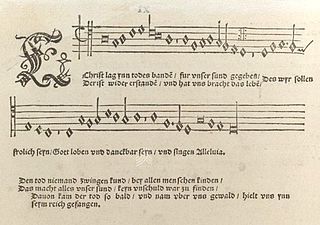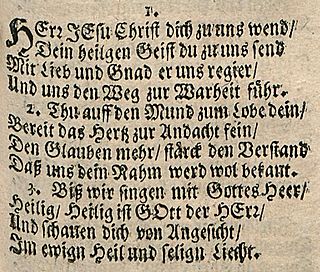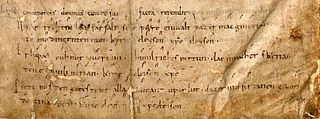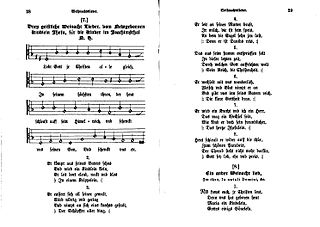Deutsche Messe was published by Martin Luther in 1526. It followed his work Formula missae from the year 1523, pertaining to the celebration of a Latin mass. Both of these masses were meant only as suggestions made on request and were not expected to be used exactly as they were, but could be altered. The function of the mass, according to Luther, is to make people hear the word.
Chorale fantasia is a type of large composition based on a chorale melody, both works for organ, and vocal settings, for example the opening movements of Bach's chorale cantatas, with the chorale melody as a cantus firmus.

"Christ lag in Todesbanden" is an Easter hymn by Martin Luther. Its melody is by Luther and Johann Walter. Both the text and the melody were based on earlier examples. It was published in 1524 in the Erfurt Enchiridion and in Walter's choral hymnal Eyn geystlich Gesangk Buchleyn. Various composers, including Pachelbel, Bach and Telemann, have used the hymn in their compositions.

"Gelobt sei Gott im höchsten Thron" is a hymn for Easter in 20 stanzas in German by Michael Weiße, widely known with a later melody by Melchior Vulpius. Shortened, it is part of current Protestant and Catholic German hymnals.

"Jesus Christus, unser Heiland, der den Tod überwand" is a hymn for Easter by Martin Luther. The text originated in 1524. Johannes Zahn listed three hymn tunes for it. Two of these, Zahn Nos. 1976 and 1977, were published in 1724. A third, Zahn No. 1978, is attributed to Luther and was first published in 1529. Variants of this melody originated up to the early 17th century.
"Jesus Christus, unser Heiland, der von uns den Gotteszorn wandt" is a Lutheran hymn in ten stanzas by Martin Luther for communion, first published in 1524 in the Erfurt Enchiridion. It is one of Luther's hymns which he wrote to strengthen his concepts of reformation. The models for the text and the melody of Luther's hymn existed in early 15th-century Bohemia. The text of the earlier hymn, "Jesus Christus nostra salus", goes back to the late 14th century. That hymn was embedded in a Hussite tradition.

"Christ unser Herr zum Jordan kam" is a Lutheran hymn about baptism by Martin Luther, written in 1541 and published in 1543. It has been set in many musical compositions, including cantatas and chorale preludes by Johann Sebastian Bach.

"Gott sei gelobet und gebenedeiet" is a Lutheran hymn of 1524 with words written by Martin Luther who used an older first stanza and melody. It is a song of thanks after communion. Luther's version in three stanzas was printed in the Erfurt Enchiridion of 1524 and in Johann Walter's choral hymnal Eyn geystlich Gesangk Buchleyn the same year. Today, the song appears in German hymnals, including both the Protestant Evangelisches Gesangbuch, and in a different version in the Catholic Gotteslob.
Advent songs are songs and hymns intended for Advent, the four weeks of preparation for Christmas. Topics of the time of expectation are the hope for a Messiah, prophecies, and the symbolism of light, among others. Several of the songs are part of hymnals such as the German Catholic Gotteslob (GL) and the Protestant Evangelisches Gesangbuch (EG).

"Herr Jesu Christ, dich zu uns wend" is a Lutheran hymn from the 17th century. Its hymn tune, Zahn No. 624, was adopted in several compositions. It was translated into English and is part of modern hymnals, both Protestant and Catholic.

The Leise or Leis is a genre of vernacular medieval church song. They appear to have originated in the German-speaking regions, but are also found in Scandinavia, and are a precursor of Protestant church music.

"Allein Gott in der Höh sei Ehr" is an early Lutheran hymn, with text and melody attributed to Nikolaus Decius. With the reformers intending church service in German, it was intended as a German version of the Gloria part of the Latin mass, used in almost every service. Decius wrote three stanzas, probably in 1523, while a fourth was added, probably by Joachim Slüter.

"Macht hoch die Tür" is a German popular Advent hymn, written in Ducal Prussia in the 17th century. The lyrics were written by Georg Weissel in 1623, for the inauguration of the Altroßgärter Kirche in Königsberg. The melody that is now associated with the text appeared first in 1704 in the hymnal by Johann Anastasius Freylinghausen.

"Lobt Gott, ihr Christen alle gleich" is a German Christmas carol with lyrics and melody by Nikolaus Herman. It is part of Protestant and Catholic hymnals, has inspired musical settings, and has been translated. The title is also known as "Lobt Gott, ihr Christen allzugleich".

"Christ fuhr gen Himmel" is a German Ascension hymn. The church song is based the medieval melody of the Easter hymn "Christ ist erstanden". It was an ecumenical song from the beginning, with the first stanza published in 1480, then included in a Lutheran hymnal in 1545, and expanded by the Catholic Johannes Leisentritt in 1567. It appears in modern German Catholic and Protestant hymnals, and has inspired musical settings by composers from the 16th to the 21st century.

"Das Grab ist leer, der Held erwacht" is a Catholic hymn for Easter, first printed in 1777 in the hymnal Landshuter Gesangbuch published by Franz Seraph von Kohlbrenner. Keeping only the first of five stanzas, with additional two stanzas, it appeared in hymnals of the 19th century, and later in different versions in several regional sections of the Catholic hymnal Gotteslob. It is a frequently sung hymn in Easter services.

"Im Frieden dein, o Herre mein" is a three-stanza German Christian communion hymn. In 1527 the early Reformer Johann Englisch wrote two stanzas as a rhyming close paraphase of the Nunc dimittis, or Canticle of Simeon. The hymn is sung to a melody by Wolfgang Dachstein, written before 1530. Friedrich Spitta revised the lyrics in 1898 and added a third stanza. His revision transformed Englisch's prayer of an individual with a focus on a peaceful death to a communal one more about peaceful life in unity.

"Kommet, ihr Hirten" is a German Christmas carol from Bohemia which was derived from a Czech carol, "Nesem vám noviny". It reflects elements from the nativity story, the annunciation to the shepherds, their walk to the manger and their Adoration, inviting to follow their example. The first line, "Kommet, ihr Hirten, ihr Männer und Fraun", addresses shepherds, men, and women.
















